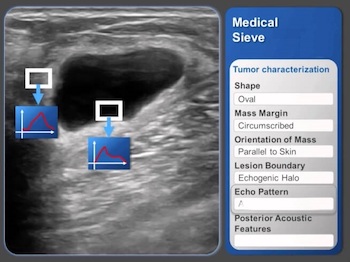
Plus Advent Calendar Door #14: Opening the black box
Many aspects of our lives today are possible thanks to machine learning – where a machine is trained to do a specific, yet complex, job. We no longer think twice about speaking to our digital devices, clicking on recommended products from online stores, or using language translation apps and websites.
Since the 1980s neural networks have been used as the mathematical model for machine learning. Inspired by the structure of our brains, each "neuron" is a simple mathematical calculation, taking numbers as input and producing a single number as an output. Originally the neural networks consisted of just one or two layers of neurons due to the computational complexity of the training process. But since the early 2000s deep neural networks consisting of many layers have been possible, and are now used for tasks that vary from pre-screening job applications to revolutionary approaches in health care.
Deep learning is increasingly important in many areas both outside and inside science. Its usefulness has been proven, but there still are a lot of unanswered questions about the theory of why such deep learning approaches work. And that is why the Isaac Newton Institute (INI) in Cambridge is running a research programme called Mathematics of deep learning (MDL) which aims to understand the mathematical foundations of deep learning.
Empirical success
"The list of applications where deep learning is used successfully is so vast that it would probably be more efficient to list the areas where it's not used!" says Anders Hansen, from the University of Cambridge. Probably the most famous application of deep learning is in image classification, for example automatically determining if there's a dog or a cat in an image. But this is a far from trivial application, as any sort of automatic process which replaces the human vision and decision system is crucial in new technologies such as self-driving cars.

Interface of Medical Sieve, an algorithm by IBM for assisting in clinical decisions. (Image: The Medical Futurist – CC BY 4.0
There have been impressive results, says Carola Schönlieb, also from the University of Cambridge, but we don't understand why the results are so good and how they work. "This is a problem especially when you want to use deep learning methods to solve sensitive decision problems like in health care or for automated driving. Mathematics is really crucial to change this and is the key to opening the black box."
Building trust
The main theme of the programme is to develop a mathematical foundation for deep learning, says Gitta Kutyniok, from LMU Munich. "We all know how successful deep learning is in [its applications in] public life, sciences and mathematics. But most of the research is empirical and there's a great need for developing a theoretical foundation."
"Trustworthiness is a very important question in applications like medical diagnosis," says Peter Bartlett, from the University of California, Berkeley. A deep learning algorithm may be very successful, but it's vital you can quantify the uncertainties of when the algorithm's predictions are more or less accurate. "Assigning an appropriate statistical confidence to the prediction is hugely important and really lacking with many of these methods."
Deep mathematics
Mathematics may be key to assessing how confident we can be about deep learning, but the empirical successes of deep learning also pose some important mathematical questions. "Some of the really exciting, the big challenges, are understanding, from the mathematical perspective, how these methods are so successful," says Barlett. For example, relatively simple approaches in deep learning, such as first order gradient methods applied to very complex systems, are very successful at solving what should be very difficult optimisation problems. "Why are these simple approaches reliably leading to good solutions? Trying to understand why that is true from a theoretical perspective is really interesting. I think it's very exciting, these are genuinely new phenomena the practitioners have unearthed."
You can read more in our full article, or watch the accompanying video from the INI, where Dan Aspel spoke to the organisers – Anders Hansen (University of Cambridge), Gitta Kutyniok (LMU Munich), Peter Bartlett (University of California, Berkeley), and Carola Schönlieb (University of Cambridge) – of the Mathematics of Deep Learning programme, running at the INI from July-Dec 2021.
You can read more about the maths of deep learning here.
Return to the Plus advent calendar 2021.
This article was produced as part of our collaboration with the Isaac Newton Institute for Mathematical Sciences (INI) – you can find all the content from the collaboration here.
The INI is an international research centre and our neighbour here on the University of Cambridge's maths campus. It attracts leading mathematical scientists from all over the world, and is open to all. Visit www.newton.ac.uk to find out more.
